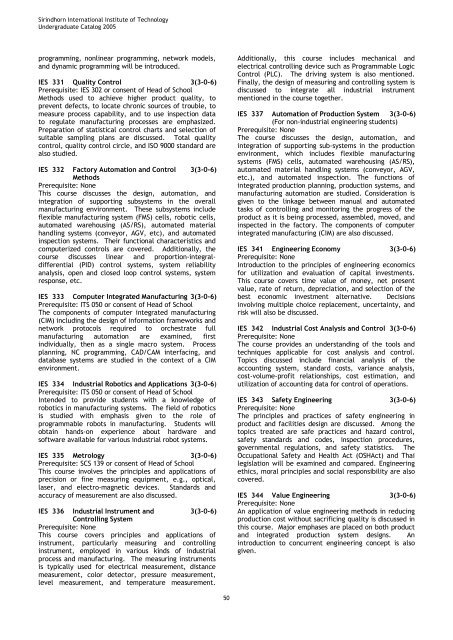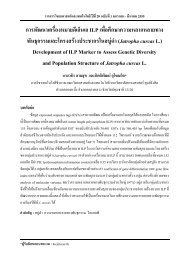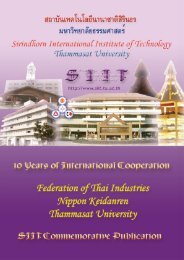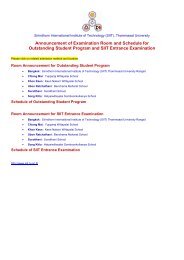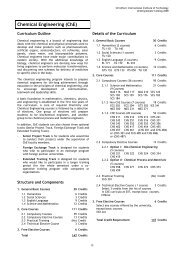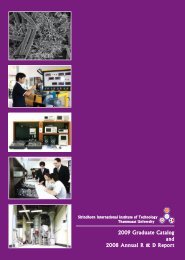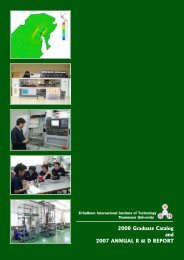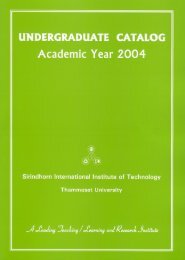Course Description - Sirindhorn International Institute of Technology
Course Description - Sirindhorn International Institute of Technology
Course Description - Sirindhorn International Institute of Technology
You also want an ePaper? Increase the reach of your titles
YUMPU automatically turns print PDFs into web optimized ePapers that Google loves.
<strong>Sirindhorn</strong> <strong>International</strong> <strong>Institute</strong> <strong>of</strong> <strong>Technology</strong><br />
Undergraduate Catalog 2005<br />
programming, nonlinear programming, network models,<br />
and dynamic programming will be introduced.<br />
IES 331 Quality Control 3(3‐0‐6)<br />
Prerequisite: IES 302 or consent <strong>of</strong> Head <strong>of</strong> School<br />
Methods used to achieve higher product quality, to<br />
prevent defects, to locate chronic sources <strong>of</strong> trouble, to<br />
measure process capability, and to use inspection data<br />
to regulate manufacturing processes are emphasized.<br />
Preparation <strong>of</strong> statistical control charts and selection <strong>of</strong><br />
suitable sampling plans are discussed. Total quality<br />
control, quality control circle, and ISO 9000 standard are<br />
also studied.<br />
IES 332 Factory Automation and Control 3(3‐0‐6)<br />
Methods<br />
Prerequisite: None<br />
This course discusses the design, automation, and<br />
integration <strong>of</strong> supporting subsystems in the overall<br />
manufacturing environment. These subsystems include<br />
flexible manufacturing system (FMS) cells, robotic cells,<br />
automated warehousing (AS/RS), automated material<br />
handling systems (conveyor, AGV, etc), and automated<br />
inspection systems. Their functional characteristics and<br />
computerized controls are covered. Additionally, the<br />
course discusses linear and proportion‐integraldifferential<br />
(PID) control systems, system reliability<br />
analysis, open and closed loop control systems, system<br />
response, etc.<br />
IES 333 Computer Integrated Manufacturing 3(3‐0‐6)<br />
Prerequisite: ITS 050 or consent <strong>of</strong> Head <strong>of</strong> School<br />
The components <strong>of</strong> computer integrated manufacturing<br />
(CIM) including the design <strong>of</strong> information frameworks and<br />
network protocols required to orchestrate full<br />
manufacturing automation are examined, first<br />
individually, then as a single macro system. Process<br />
planning, NC programming, CAD/CAM interfacing, and<br />
database systems are studied in the context <strong>of</strong> a CIM<br />
environment.<br />
IES 334 Industrial Robotics and Applications 3(3‐0‐6)<br />
Prerequisite: ITS 050 or consent <strong>of</strong> Head <strong>of</strong> School<br />
Intended to provide students with a knowledge <strong>of</strong><br />
robotics in manufacturing systems. The field <strong>of</strong> robotics<br />
is studied with emphasis given to the role <strong>of</strong><br />
programmable robots in manufacturing. Students will<br />
obtain hands‐on experience about hardware and<br />
s<strong>of</strong>tware available for various industrial robot systems.<br />
IES 335 Metrology 3(3‐0‐6)<br />
Prerequisite: SCS 139 or consent <strong>of</strong> Head <strong>of</strong> School<br />
This course involves the principles and applications <strong>of</strong><br />
precision or fine measuring equipment, e.g., optical,<br />
laser, and electro‐magnetic devices. Standards and<br />
accuracy <strong>of</strong> measurement are also discussed.<br />
IES 336 Industrial Instrument and 3(3‐0‐6)<br />
Controlling System<br />
Prerequisite: None<br />
This course covers principles and applications <strong>of</strong><br />
instrument, particularly measuring and controlling<br />
instrument, employed in various kinds <strong>of</strong> industrial<br />
process and manufacturing. The measuring instruments<br />
is typically used for electrical measurement, distance<br />
measurement, color detector, pressure measurement,<br />
level measurement, and temperature measurement.<br />
Additionally, this course includes mechanical and<br />
electrical controlling device such as Programmable Logic<br />
Control (PLC). The driving system is also mentioned.<br />
Finally, the design <strong>of</strong> measuring and controlling system is<br />
discussed to integrate all industrial instrument<br />
mentioned in the course together.<br />
IES 337 Automation <strong>of</strong> Production System 3(3‐0‐6)<br />
(For non‐industrial engineering students)<br />
Prerequisite: None<br />
The course discusses the design, automation, and<br />
integration <strong>of</strong> supporting sub‐systems in the production<br />
environment, which includes flexible manufacturing<br />
systems (FMS) cells, automated warehousing (AS/RS),<br />
automated material handling systems (conveyor, AGV,<br />
etc.), and automated inspection. The functions <strong>of</strong><br />
integrated production planning, production systems, and<br />
manufacturing automation are studied. Consideration is<br />
given to the linkage between manual and automated<br />
tasks <strong>of</strong> controlling and monitoring the progress <strong>of</strong> the<br />
product as it is being processed, assembled, moved, and<br />
inspected in the factory. The components <strong>of</strong> computer<br />
integrated manufacturing (CIM) are also discussed.<br />
IES 341 Engineering Economy 3(3‐0‐6)<br />
Prerequisite: None<br />
Introduction to the principles <strong>of</strong> engineering economics<br />
for utilization and evaluation <strong>of</strong> capital investments.<br />
This course covers time value <strong>of</strong> money, net present<br />
value, rate <strong>of</strong> return, depreciation, and selection <strong>of</strong> the<br />
best economic investment alternative. Decisions<br />
involving multiple choice replacement, uncertainty, and<br />
risk will also be discussed.<br />
IES 342 Industrial Cost Analysis and Control 3(3‐0‐6)<br />
Prerequisite: None<br />
The course provides an understanding <strong>of</strong> the tools and<br />
techniques applicable for cost analysis and control.<br />
Topics discussed include financial analysis <strong>of</strong> the<br />
accounting system, standard costs, variance analysis,<br />
cost‐volume‐pr<strong>of</strong>it relationships, cost estimation, and<br />
utilization <strong>of</strong> accounting data for control <strong>of</strong> operations.<br />
IES 343 Safety Engineering 3(3‐0‐6)<br />
Prerequisite: None<br />
The principles and practices <strong>of</strong> safety engineering in<br />
product and facilities design are discussed. Among the<br />
topics treated are safe practices and hazard control,<br />
safety standards and codes, inspection procedures,<br />
governmental regulations, and safety statistics. The<br />
Occupational Safety and Health Act (OSHAct) and Thai<br />
legislation will be examined and compared. Engineering<br />
ethics, moral principles and social responsibility are also<br />
covered.<br />
IES 344 Value Engineering 3(3‐0‐6)<br />
Prerequisite: None<br />
An application <strong>of</strong> value engineering methods in reducing<br />
production cost without sacrificing quality is discussed in<br />
this course. Major emphases are placed on both product<br />
and integrated production system designs. An<br />
introduction to concurrent engineering concept is also<br />
given.<br />
50


